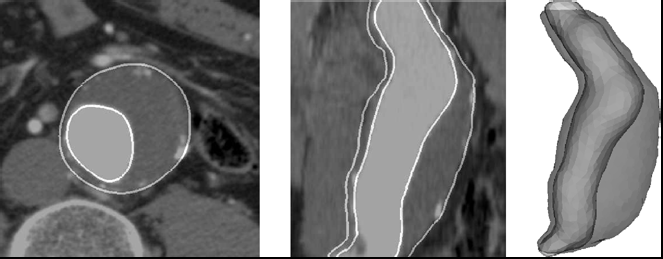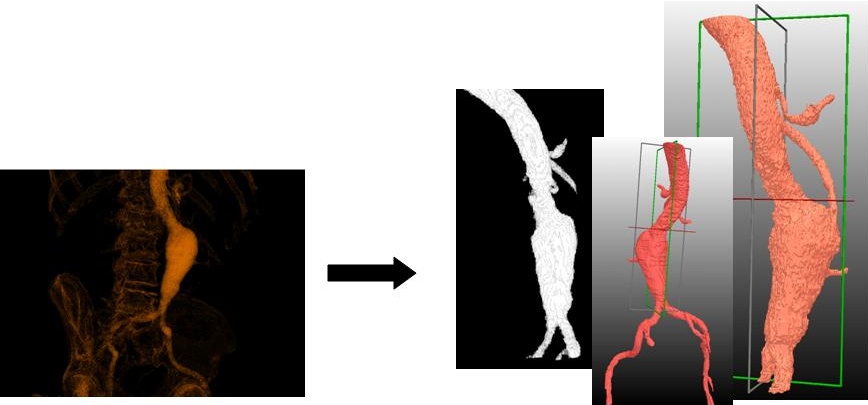Diploma thesis: Hybrid Segmentation Method for Treatment Planning of Abdominal Aortic Aneurysms
(Can be adapted to MA/BA/SEP/IDP)Advisor: Nassir Navab
Supervision by: Stefanie Demirci, Max Baust
Abstract
The workflow of general medical interventions consists of three important steps: clinical diagnosis, treatment planning and the intervention itself. The diagnosis process is mostly supported by three-dimensional (3D) imaging modalities such as computed tomography (CT) which, in case of vascular interventions, is also used for the treatment planning.
Segmentation of aorta lumen and aneurysm thrombus, Source: [3]
In case of high rupture risk, the preferred treatment today is a minimally invasive procedure based on endovascular placement of an aortic stent graft. In order to perform this procedure successfully, the appropriate stent graft device has to be selected during treatment planning. Therefore, accurate measurement tools are required in order to calculate the stent graft’s preferred size out of the preoperatively acquired CT volume. Moreover, Physicians need to choose the right material in order to suppress rupture and locations of high pressure. A thorough segmentation of both the aorta and the aneurysm can provide more information about the characteristics of the aortic wall and the stent graft’s effect on it.
This thesis concentrates on a solution for the more difficult segmentation of the aneurysm thrombus. The idea is to combine information about the geometric appearance with statistical texture information.

Tasks
- Review of different segmentation methods
- Validation of procedures in collaboration with Prof. Wall (MW)
- Implementation of problem-specific segmentation method (basic algorithms already exist)
- Validation of method on synthetic test data and real patient data in collaboration with Prof. Bauernschmitt (Deutsches Herzzentrum) and Dr. Ghotbi (Kreisklinik München-Pasing)
- Integration into existing software
Requirements
- A good knowledge of C++ is mandatory.
- Basic knowledge of image processing methods is required.
- An adequate education and interest in mathematics is required.
- Interest in medical applications is required and knowledge can be acquired during DA.
| Students.ProjectForm | |
|---|---|
| Title: | Hybrid Segmentation Method for Treatment Planning of Abdominal Aortic Aneurysms |
| Abstract: | Abdominal aortic aneurysm (AAA) is a vascular disease that results in an enlargement of the abdominal aorta due to weakened aortic wall. The preferred treatment today is a minimally invasive procedure based on endovascular placement of an aortic stent graft. In order to perform this procedure successfully, the appropriate stent graft device has to be selected during treatment planning. Therefore, accurate measurement tools are required in order to calculate the stent graft’s preferred size out of the preoperatively acquired CT volume. Moreover, Physicians need to choose the right material in order to suppress rupture and locations of high pressure. A thorough segmentation of both the aorta and the aneurysm can provide more information about the characteristics of the aortic wall and the stent graft’s effect on it. |
| Student: | Guy Lejeune |
| Director: | Nassir Navab |
| Supervisor: | Stefanie Demirci, Max Baust |
| Type: | DA/MA/BA |
| Area: | Segmentation, Medical Imaging, Computer-Aided Surgery |
| Status: | finished |
| Start: | 2008/02/01 |
| Finish: | 2008/09/01 |